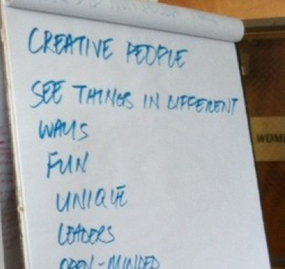 If you’re not a “creative,” you’ve probably been annoyed by a creative’s lack of organization or follow-through at some point. You may even be reveling in the recent onslaught of articles arguing that creative employees only waste time and money.
If you’re not a “creative,” you’ve probably been annoyed by a creative’s lack of organization or follow-through at some point. You may even be reveling in the recent onslaught of articles arguing that creative employees only waste time and money.
But no matter how “Type A” you are, you can’t afford to overlook creatives’ potential in this increasingly innovation-focused market.
I understand where this “no creatives” sentiment is coming from. I once worked with a company that hired a cohort of creative individuals to “inject some enthusiasm” and drive growth. We soon discovered that these free spirits were a combination of unwilling and incapable when it came to learning our baseline technology elements and imparting them to customers.
Although hiring creatives hurt that business, the lesson here isn’t to rid your company of creative types. Rather, the real solution is to vet each hire carefully to find creatives who round out your company, fit in your culture, and create balance between innovation and results.
The Dangers of Eliminating Creatives
Welcoming creativity does more than make your business seem like a fun place to work; it drives growth. If you eradicate creatives from the workplace, be prepared to face these consequences:
- Artificial limits on growth: The most creative ideas drive opportunities to meet customers’ unmet needs and tap into potential new markets.
- An inability to identify unique solutions: The typical problems most businesses face are not simple, linear, or procedural in nature. If you eliminate creatives, you may overlook novel solutions, which rarely come from standard methods of analysis and thought.
- Ineffective communication: The ability to communicate and position an enterprise successfully requires the talents of brand and image specialists who inject creative thinking into the process. Creatives can engage with customers, position your organization in the marketplace, and build brand equity, which will contribute to long-term success.
How the Balancing Act Works
Of course, there are plenty of dangers to only hiring creatives, as well. If you’ve ever known a happily married couple who seemed to validate the “opposites attract” theory, you understand how two contrasting personality types can complement each other to form a stronger unit.
Healthy organizations strive to create a balance between creatives and process-driven, analytical employees. A diverse workforce can help businesses:
- Understand their broader market and identify a wider range of needs their company can meet.
- Play off of employees’ varied skill sets to extract their best work and apply those abilities to internal demands.
- Safeguard the long-term success of the company by helping creatives follow through on their visions.
- Prevent the process-driven from getting trapped in a cycle of sameness when faced with a changing business environment.
- Create a vibrant and welcoming environment that helps attract top talent and boosts employee retention.
How to Create the Perfect Balance
Although these outcomes sound fantastic, you have to develop your diversified culture the right way to reap the benefits.
I once worked with a client who decided to shake things up by bringing in a leader known for her creativity. The CEO gave this new vice president complete freedom to make changes in the organization.
Unfortunately, the organization wasn’t equipped to support her sweeping changes. The vice president tried to do too much too quickly without bringing the organization and team along with her, so her efforts fell short in improving the company.
If you want to embrace creativity and get employees on board with changes, consider these tips:
- Encourage interaction between potential candidates and team members during the hiring process. Include people new hires will report to, potential peers, and people who will report to them. Gather feedback from those interactions.
- Recognize that creativity thrives on the tension between the freedom to explore and the constraints of business demands. Use that thinking to strike a balance when hiring.
- Remember there are other personality preferences and traits beyond the labels of “creative” and “procedural.” Hire for culture fit, and consider a candidate’s knowledge, skills, and experience.
- Focus your attention on setting clear expectations at the start to unify the intended output from team members. Encourage your diverse team to focus on external goals rather than individual needs, and its efforts will come together effectively.
- Don’t dictate how you want work accomplished. Set targets, and let teams determine the best way to achieve their goals. Organizing the workload is one way diverse team members learn to appreciate one another’s unique skills and expertise.
If you follow the anti-creative movement, then play it safe, copy proven strategies, and your organization will probably do well — for a short time.
But if you want to be capable of adapting to changes in the market, accomplish something beyond business hygiene, and experience growth, you’re going to need those creatives. Shut out that foolish babble and build a diverse team that can help you achieve productive innovation that leads to real growth.
image from Buffalo State Univ.